PR
X
Keyword Search
▼キーワード検索
Comments
私はイスラム教徒です@ Re:アイルランド・ロンドンへの旅(その131): ロンドン散策記・アルバート記念碑(Albert Memorial)-2(11/06)
神神は言った: コーランで 『 (21) 人々…
私はイスラム教徒です@ Re:アイルランド・ロンドンへの旅(その122): ロンドン散策記・Victoria and Albert Museum・ヴィクトリア&アルバート博物館-5(10/28)
神神は言った: コーランで 『 (21) 人…
【甥の救急車での搬…
 New!
Gママさん
New!
Gママさん
続日本100名城東北の… New! オジン0523さん
岡山県立森林公園(1)… New!
隠居人はせじぃさん
New!
隠居人はせじぃさん
ムベの実を開くコツ… noahnoahnoahさん
noahnoahnoahさん
エコハウスにようこそ ecologicianさん
 New!
Gママさん
New!
Gママさん続日本100名城東北の… New! オジン0523さん
岡山県立森林公園(1)…
 New!
隠居人はせじぃさん
New!
隠居人はせじぃさんムベの実を開くコツ…
 noahnoahnoahさん
noahnoahnoahさんエコハウスにようこそ ecologicianさん
Calendar
カテゴリ: 海外旅行
中国ギャラリー(China Gallery, Rooms 44–47f) へ。
V&A の中国ギャラリーでは、以下のような展示が見られた。
・陶磁器(唐三彩、宋磁、青花磁器など)
・彫刻(仏像、墓俑)
・漆工芸や金属器・書画や家具このように、日本ギャラリーと同様に、中国美術・工芸の
歴史を通観できる構成になっていた。

日本展示の隣にあった。
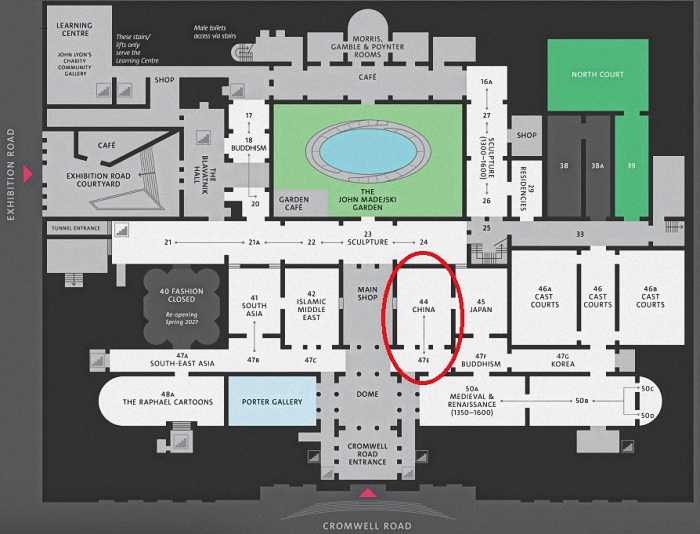
・手前中央のガラスケースには、大型の青銅器のような中国古代の工芸品が展示されていた。
・左側には大きな屏風や掛軸のような展示(山水画のパネル)が確認できた。
・建築的には高い天井とアーチ状の白い柱列があり、展示室全体を開放的に見せていた。
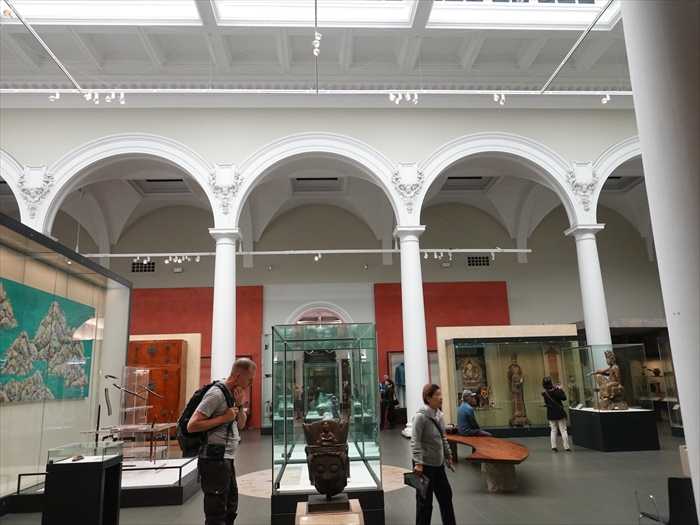
廻り込んで。

刺繍や織物(タペストリー)作品 。
・左(黄色地)
花と鳥を描いた刺繍。おそらく「花鳥図」の伝統に基づき、四季や吉祥を象徴するモチーフ。
梅・牡丹・鳥などが典型的。
梅・牡丹・鳥などが典型的。
・中央(青地)
高僧か仙人(道教の人物)を描いた刺繍。周囲に鳥や瑞兆的なモチーフがあしらわれていた。
細かい糸使いで、礼服や壁掛けに用いられたのであろう。
細かい糸使いで、礼服や壁掛けに用いられたのであろう。
・右(淡黄色地)
魚や水草、鳥をあしらった刺繍。豊穣・長寿・吉祥を意味する伝統的意匠。
左端には縦に並んだ 黒地の刺繍裂 があり、器物や花鳥の文様が細かく縫い込まれていた。

中国ギャラリーの「 Textile furnishings(室内織物調度) 」に関する説明。
上段(セクション解説)
「 LIVING – Textile furnishings
「 LIVING – Textile furnishings
The textiles shown here were made for wealthy Chinese households.
While some were purely ornamental, many served a practical as well as decorative
purpose. Certain sets of furnishings were reserved for use only on special occasions.」
【 生活 ― 織物調度品
purpose. Certain sets of furnishings were reserved for use only on special occasions.」
【 生活 ― 織物調度品
ここに展示されている織物は、裕福な中国の家庭のために作られたものです。
純粋に装飾的なものもあれ ば、実用性と装飾性を兼ねたものもあります。中には特別な
機会にのみ用いられた調度品もありました。】
純粋に装飾的なものもあれ ば、実用性と装飾性を兼ねたものもあります。中には特別な
機会にのみ用いられた調度品もありました。】
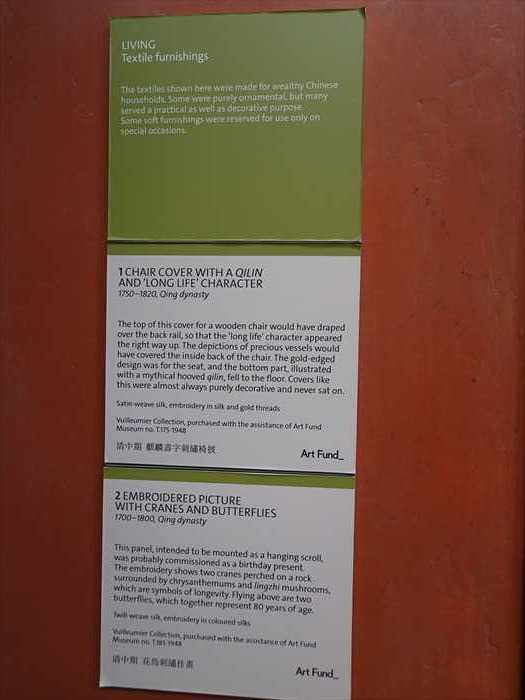
写真中央(床の上に配置された石像・石柱)
・石柱(2本):
仏教関連の浮彫が施されており、仏や菩薩、小型の仏塔などが段状に
彫られていた
中国の石窟寺院や墓碑用の石柱(唐〜宋代の影響を受けたもの)。
彫られていた
中国の石窟寺院や墓碑用の石柱(唐〜宋代の影響を受けたもの)。
・石像(手前):
二体並んだ人物像を刻んだ石造彫刻。石仏や供養碑の一部であろう。
背景ショーケース(左から右へ)
1.赤い織物(左端)
大きな円形の文様が織り出された中国の織物。おそらく 錦織(brocade) で、仏教儀礼
または宮廷用のテキスタイル。
または宮廷用のテキスタイル。
2.金色の仏像(中央奥)
おそらく 金銅仏(gilt-bronze Buddha)。唐代以降の中国仏像の特徴があり、
堂々とした坐像姿。
堂々とした坐像姿。
3.青地に花鳥文の大掛布(右側)
大型の刺繍織物で、壁掛け(hanging)または衣装用の断片。
精緻な花鳥文様が施され、清代の宮廷刺繍に典型的な作例。
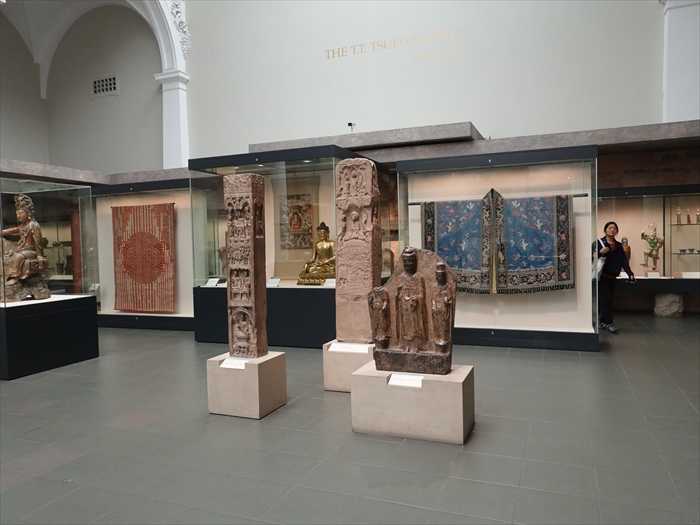
上段(左から右へ)
1.小さな青磁杯(2点)
・高台のある小型の杯。青磁釉で、宋~元代の酒器か祭器と思われます。
2.丸壺(青花大壺)
・胴部に龍文が描かれた青花磁器。明代(15~16世紀頃)の景徳鎮窯に典型的なスタイル。
3.灰色の双耳壺
ハンドル部に動物形の装飾がある。
4.双耳大壺(青花)
・首の両側にドラゴン形の持ち手を付けた大きな青花磁器。細かな唐草文様。
明~清代の景徳鎮製と考えられる
下段(左から右へ)
1.青磁小壺と皿
・小型の瓶と浅皿。宋代龍泉窯の青磁か、それを模した後代のもの。
2.白磁皿・灰釉碗など
3.青花大皿(中央)
・碗形の大皿で、花鳥唐草文が描かれている。
明代後期~清初の輸出磁器によく見られるタイプ。
4.青花中皿と小皿
・青花で同心円模様や花文が施されている。
17世紀頃の景徳鎮窯の作品か。
5.青銅香炉(2点)
・右奥にある黒っぽい青銅製の香炉(蓋付)と、さらに右の獣脚を持つ小型香炉。
いずれも明~清代の祭器。
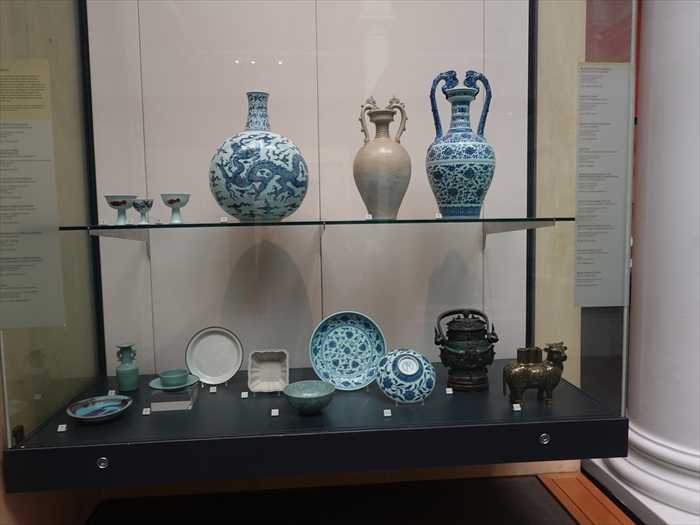
V&A(ヴィクトリア&アルバート博物館)中国ギャラリーにある展示の説明で、
テーマは 「RULING – Pursuit of Antiquity(統治 ― 古代の探求)」
「 RULING – Pursuit of Antiquity
The Qing emperors considered themselves protectors of China’s cultural heritage.
In the 18th century, ambitious projects were launched to build the palace collections of
antiques. The treasures amassed ranged from calligraphy and paintings by greatmasters
to archaic bronze vessels and rare 12th-century imperial ru wares.Catalogues of the
collections were also compiled. This fascination with antiquity alsoinfluenced
contemporary works produced in the imperial workshop: new objects weremade
in deliberate imitation of antiques from the past.
Nos. 1, 7, 10, 12 and 15 from the Eumorfopoulos collection. Purchased with theIn the 18th century, ambitious projects were launched to build the palace collections of
antiques. The treasures amassed ranged from calligraphy and paintings by greatmasters
to archaic bronze vessels and rare 12th-century imperial ru wares.Catalogues of the
collections were also compiled. This fascination with antiquity alsoinfluenced
contemporary works produced in the imperial workshop: new objects weremade
in deliberate imitation of antiques from the past.
assistance of the Art Fund, the Vallentin Bequest, Sir Percival David and the
Universities China Committee.」
【統治 ― 古代の探求清朝の皇帝たちは、自らを中国文化遺産の守護者と考えていました。
18世紀には、宮廷の古美術コレクションを築くために壮大な事業が進められました。
収集された宝物は、名匠による書画から古代の青銅器、そして希少な12世紀の宮廷用
「汝窯(るよう)」の陶磁器にまで及びました。こうしたコレクションの目録も作成
されました。この古代への憧憬はまた、宮廷工房で制作された同時代の作品にも影響を
与えました。新たな作品が、過去の古美術を意図的に模倣して作られたのです。
(展示品のうち、1・7・10・12・15はエウモルフォプロス・コレクションから。
Art Fund、ヴァレンティン遺贈、パーシヴァル・デイヴィッド卿、中国大学委員会の援助に
より購入。)】
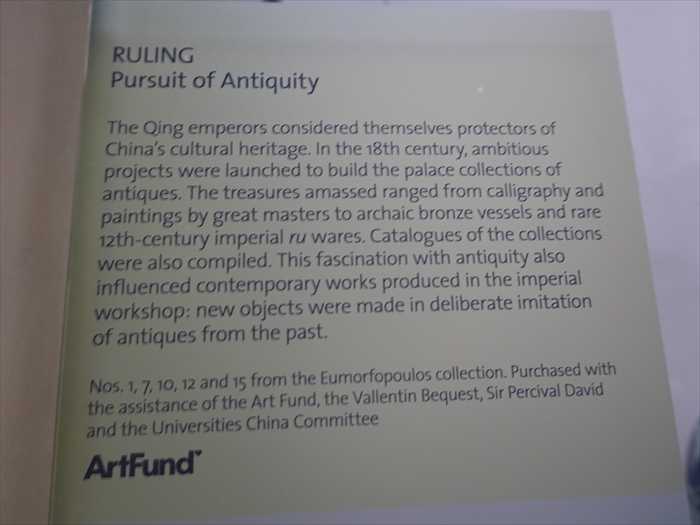
壁一面に沿って設置された陶磁器の長い展示ケースで、宋~元~明~清にかけての
小型の壺、瓶、盃、香炉、青磁などが並んでいた。

陶磁器と青銅器 などを一緒に展示。
●上段
・左端:青花大壺(魚文様、明代末~清初の輸出磁器に典型的)
・中央:青銅器(提梁壺=持ち手付き青銅容器、戦国~漢時代を模したものか)
・その右:家屋形の青銅容器(祭祀用または埋葬用の模型器の一種)
・右端:三彩大壺(唐三彩に類する色釉の大壺)
●中段
・左:小碗や小皿(唐三彩や緑釉器を思わせる)
・中央:白地に赤茶色の文様が施された陶製の注器(イスラーム陶器風、中国で模倣された
「西域風デザイン」か)
「西域風デザイン」か)
・右2点:銅または青銅の水差し(唐~宋時代、中国とイスラーム文化圏との交流を示す)
・右端:褐釉の注口器
● 下段(ラベルが見える部分)
小型の器群(唐代~宋代の輸出陶磁)とみられる。
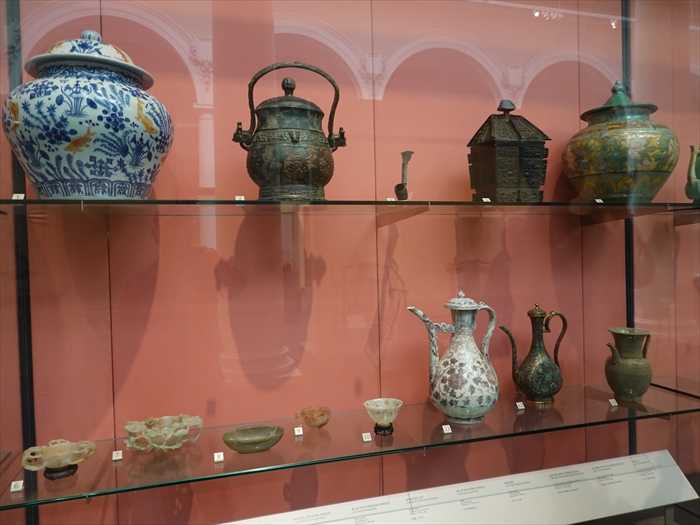
「Chinese wine was made from rice, until the grapevine was introduced to China
via the Middle East during the 2nd century BC.
Scholars and literati approved of wine, believing that their creative powers were
stimulated by alcohol. Consequently, many great poets and calligraphers wereknown
for their love of drinking.
Wine was also offered to deities and the dead during ritual worship. Jade wine cupsstimulated by alcohol. Consequently, many great poets and calligraphers wereknown
for their love of drinking.
had an added significance for Daoist followers, who believed jade to have a preserving
effect on the body.」
【中国の酒は米から造られていましたが、紀元前2世紀に中東を経由してブドウの木が
中国に伝わりました。
学者や文人たちは酒を良しとし、酒によって創造力が刺激されると信じていました。
そのため、多くの偉大な詩人や書家たちは酒好きとして知られていました。
また、酒は神々や死者への祭祀においても供えられました。玉(翡翠)の酒杯は道教徒にそのため、多くの偉大な詩人や書家たちは酒好きとして知られていました。
とって特別な意味を持ち、玉が身体に保存的な効果を与えると信じられていました。】
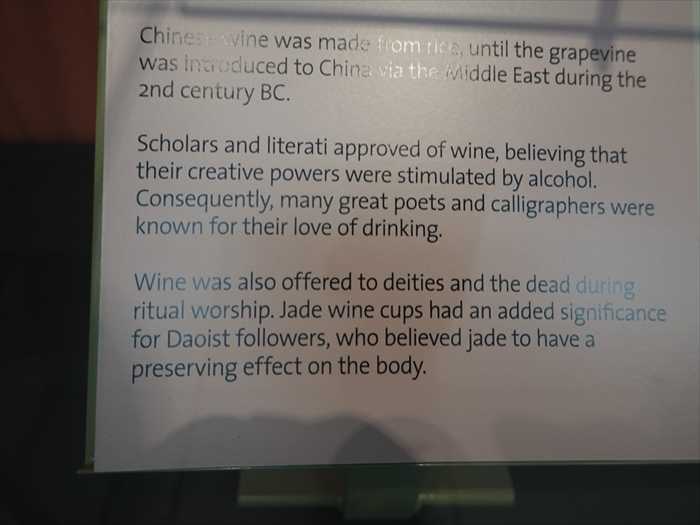
ヴィクトリア&アルバート博物館(V&A Museum)内の ミュージアムショップ が隣に。

「 Islamic Middle East(イスラム中東) 」ギャラリー の入口サイン。
・展示範囲
西アジア・北アフリカを中心とするイスラム世界の工芸・美術を扱っています。
展示物は 7世紀のイスラム成立以降~現代まで に及び、地域もスペイン(アンダルス)から
インドまで幅広いです。
インドまで幅広いです。
・展示される主な作品
・イスラム陶器(特にイラン、トルコのイズニク陶器)
・金属工芸(真鍮・銀象嵌器など)
・織物(ペルシャ絨毯、カフタン、刺繍布)
・書道・写本(コーラン写本、装飾的カリグラフィー)
・建築装飾(幾何学・アラベスク模様のタイル、木彫)

「Islamic Middle East(イスラム中東)」ギャラリーのイントロダクション展示 。
壁面には解説文と、 典型的なイスラム装飾タイル(星形・多角形の幾何学パターン)
が並んでいた。

「 The Islamic Middle East
religious expression and a key marker of status in both a religious and a political system.」
【 イスラム中東
おける身分を示す重要な象徴であり続けました。】

「 Bowl with Sailing Ship・ 帆船文の鉢 」。
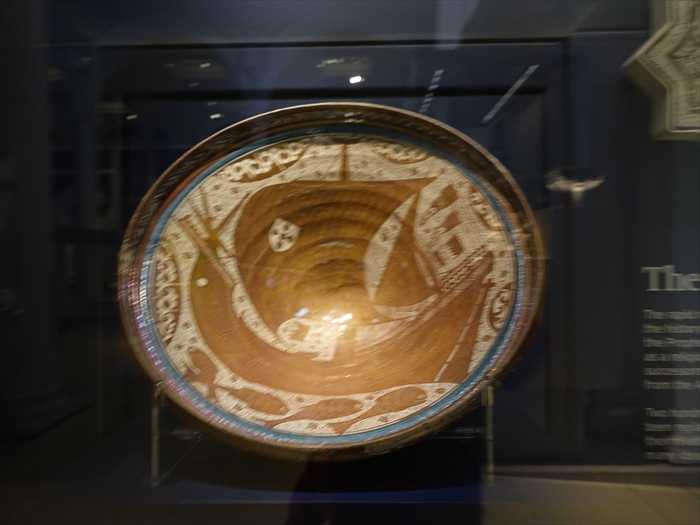
「 Lustre Tiles・ラスター彩タイル 」。

「 The Islamic Middle East
The rapid rise of Islam in the 7th century AD transformed the history of the
Middle East.The religion was founded by the Prophet Muhammad, and after
his death in 632 it wasruled as a religious and political state. Within 100 years
it had expanded across threecontinents. By 750 it stretched from the Atlantic Ocean
to the borders of India.
Middle East.The religion was founded by the Prophet Muhammad, and after
his death in 632 it wasruled as a religious and political state. Within 100 years
it had expanded across threecontinents. By 750 it stretched from the Atlantic Ocean
to the borders of India.
Two hundred years later this single Islamic empire had fragmented under the number
of competing states. Despite these rivalries, the Muslim rulers of the time sharedmany
ideas on culture and politics, as well as religion.
of competing states. Despite these rivalries, the Muslim rulers of the time sharedmany
ideas on culture and politics, as well as religion.
This common Islamic heritage was maintained until the 1920s. By then, almostthe
whole region was under European colonial control. In most Muslim societies Islam
remains the most important source of law, education and culture.
Throughout its long political history, art continued to be the principal means ofwhole region was under European colonial control. In most Muslim societies Islam
remains the most important source of law, education and culture.
religious expression and a key marker of status in both a religious and a political system.」
【 イスラム中東
紀元7世紀におけるイスラム教の急速な台頭は、中東の歴史を大きく変革しました。イスラム教は
預言者ムハンマドによって創始され、632年の彼の死後、宗教的かつ政治的な国家として
統治されました。その100年以内に、イスラムは三大陸に拡大し、750年までには大西洋から
インドの国境にまで及びました。
預言者ムハンマドによって創始され、632年の彼の死後、宗教的かつ政治的な国家として
統治されました。その100年以内に、イスラムは三大陸に拡大し、750年までには大西洋から
インドの国境にまで及びました。
その200年後、この単一のイスラム帝国は、複数の競合する国家に分裂しました。しかし
こうした対立にもかかわらず、当時のイスラムの支配者たちは、宗教のみならず文化や政治に
おいても多くの理念を共有していました。
こうした対立にもかかわらず、当時のイスラムの支配者たちは、宗教のみならず文化や政治に
おいても多くの理念を共有していました。
この共通のイスラム遺産は1920年代まで保持されました。その頃までに、この地域の
ほとんどはヨーロッパ列強の植民地支配下に置かれていました。現代においても、多くの
イスラム社会では、イスラム教が法律・教育・文化の最も重要な基盤であり続けています。
長い政治史を通じて、芸術は宗教的表現の主要な手段であると同時に、宗教的・政治的秩序にほとんどはヨーロッパ列強の植民地支配下に置かれていました。現代においても、多くの
イスラム社会では、イスラム教が法律・教育・文化の最も重要な基盤であり続けています。
おける身分を示す重要な象徴であり続けました。】

「 Bowl with Sailing Ship・ 帆船文の鉢 」。

「 Lustre Tiles・ラスター彩タイル 」。
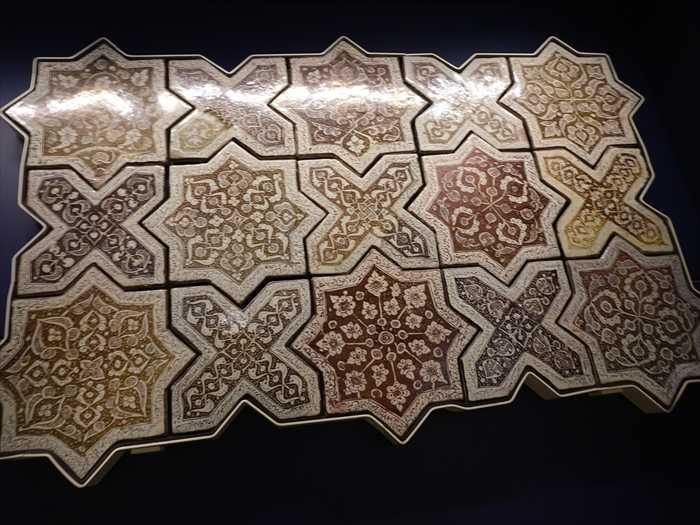
「 Bowl with Sailing Ship
(left)
Spain, Málaga
1425
Málaga in Spain was still under Muslim rule when this large bowl was made.
The city had been an important centre of lustre production since the early
13th century, and its wares were exported as far as England and Egypt.
The city had been an important centre of lustre production since the early
13th century, and its wares were exported as far as England and Egypt.
This bowl may have been made for the export trade. It shows a long-haul sailing
ship of the period with the arms of Christian-ruled Portugal on its sail.
ship of the period with the arms of Christian-ruled Portugal on its sail.
Earthenware under an opaque white glaze, with colour in and lustre over the glaze
Museum no. 486-1864」【 帆船文の鉢
(左)
スペイン、マラガ
1425年
この大きな鉢が作られた当時、スペインのマラガはまだイスラム支配下にありました。
マラガは13世紀初頭からラスター彩陶の重要な生産地であり、その製品はイングランドや
エジプトにまで輸出されていました。
マラガは13世紀初頭からラスター彩陶の重要な生産地であり、その製品はイングランドや
エジプトにまで輸出されていました。
この鉢は輸出用に作られた可能性があります。帆にはキリスト教支配下のポルトガルの紋章が
描かれた、当時の遠洋帆船が表されています。
描かれた、当時の遠洋帆船が表されています。
白濁した白釉の下に陶器胎土を用い、上に彩色とラスター彩を施す。
館蔵番号:486-1864】「 Lustre Tiles(right)Iran ,
probably Kashan1262Many innovations originated in the
Islamic Middle East. Decorating glazed ceramicswith metallic lustre was one of them.
This difficult technique was invented in Iraq in the 9th century. It spread over an area
stretching from Spain to Iran, where thesetiles were made.The tiles are from the
tomb of a descendant of the Prophet Muhammad at Varaminnear Teheran.
The designs, each subtly different, are surrounded by quotations fromthe Qur’an.
Fritware painted in lustre over transparent glaze
Museum nos.
1487, 1489, 18376A, C, E, F, 18388C, E-1876; 1077, 10996A, 11006」
【 ラスター彩タイル
(右)
イラン、おそらくカーシャーン
1262年
多くの革新的技法がイスラム中東で生まれました。金属光沢をもつラスター彩で陶器に装飾する
技法もその一つです。この難しい技法は9世紀のイラクで発明され、スペインからイランに至る
広範囲に広まりました。
技法もその一つです。この難しい技法は9世紀のイラクで発明され、スペインからイランに至る
広範囲に広まりました。
これらのタイルは、テヘラン近郊ヴァラーミンにある預言者ムハンマドの子孫の墓から出土
したものです。それぞれ微妙に異なる文様は、クルアーンの引用句に囲まれています。
したものです。それぞれ微妙に異なる文様は、クルアーンの引用句に囲まれています。
透明釉の上にラスター彩を施したフリット陶。
館蔵番号:1487, 1489, 18376A, C, E, F, 18388C, E-1876; 1077, 10996A, 11006A-1892】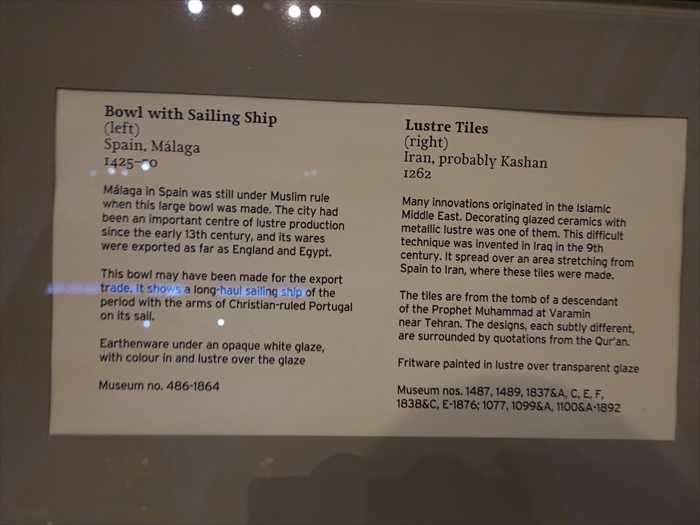
・左上の大きな青緑色の壺(ターコイズ釉壺)
ペルシャ(イラン)でよく見られる12~14世紀の陶器。厚手の胎土に鮮やかなターコイズ釉を
施し、表面には浮彫文様(幾何学模様や植物文様)が見られるのが特徴です。
・その下の金属製水差しや陶器
施し、表面には浮彫文様(幾何学模様や植物文様)が見られるのが特徴です。
・その下の金属製水差しや陶器
真鍮や青銅に銀象嵌を施した水差し、またガラス器・陶器も見られます。特にエジプト・
シリア地域で盛んに作られた「マムルーク様式」の金属器が含まれている可能性があります。
・中央奥の長い縦の展示物(赤褐色)
シリア地域で盛んに作られた「マムルーク様式」の金属器が含まれている可能性があります。
・中央奥の長い縦の展示物(赤褐色)
建築装飾やレリーフ片と思われます。イスラーム建築の壁面を飾ったスタッコ(漆喰彫刻)や
タイル断片の可能性があります。
タイル断片の可能性があります。
・右側のガラスケース
小型の瓶や水差し、壺など。多くはイランやシリアで制作された青釉陶器・ラスター彩陶器。
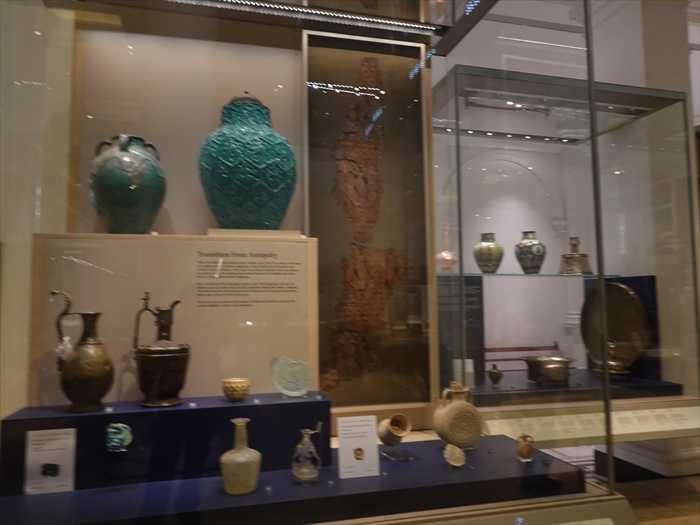
「 Transition from Antiquity
When the Middle East passed under Islamic rule in the 7th century, there was no
sudden break in artistic production. Early Islamic art continued much of what
hadgone before. Yet it was not a simple transition from one culture to another,
since the eastern and western halves of the Middle East were heirs to two distinct
artistic traditions.
sudden break in artistic production. Early Islamic art continued much of what
hadgone before. Yet it was not a simple transition from one culture to another,
since the eastern and western halves of the Middle East were heirs to two distinct
artistic traditions.
One originated in the Sasanian empire, which had ruled Iraq, Iran and the western
part of Central Asia for four centuries before the Islamic conquest. The other was the Christianised form of Roman art we know as Byzantine, which was current in Syria
and Egypt.
Islamic art was formed by the merger of these two traditions, and by the gradualpart of Central Asia for four centuries before the Islamic conquest. The other was the Christianised form of Roman art we know as Byzantine, which was current in Syria
and Egypt.
addition of many new elements.」
【 古代からの移行
中東が7世紀にイスラーム支配下に入ったとき、芸術生産において突然の断絶はありません
でした。初期イスラーム美術は、それ以前の多くを継承していました。しかし、それは単に
一つの文化から別の文化への移行ではありませんでした。なぜなら、中東の東西両半は、
それぞれ異なる二つの芸術的伝統を受け継いでいたからです。
でした。初期イスラーム美術は、それ以前の多くを継承していました。しかし、それは単に
一つの文化から別の文化への移行ではありませんでした。なぜなら、中東の東西両半は、
それぞれ異なる二つの芸術的伝統を受け継いでいたからです。
一つは、イスラーム征服以前の4世紀にわたりイラク、イラン、中央アジア西部を支配して
いたサーサーン朝に由来するものです。もう一つは、我々がビザンツ美術として知る、
ローマ美術のキリスト教化された形態であり、シリアやエジプトで広まっていました。
イスラーム美術は、これら二つの伝統が融合し、さらに多くの新要素が徐々に加わることにいたサーサーン朝に由来するものです。もう一つは、我々がビザンツ美術として知る、
ローマ美術のキリスト教化された形態であり、シリアやエジプトで広まっていました。
よって形成されました。】

柱頭(capital、キャピタル) 。
・柱頭とは、建築における柱の最上部に置かれる部分で、柱と梁・アーチをつなぐ構造材。
・写真のものは、ビザンツ美術やイスラーム初期美術でよく見られるスタイル。
・手前の柱頭はギリシャ・ローマ建築の伝統を受け継ぐコリント式柱頭 (渦巻き=ヴォリュート装飾とア
カンサス葉)に近い形式。
カンサス葉)に近い形式。
・奥の柱頭は葉文様が細かく透かし彫りされ、より装飾的で、光を透かすことで建築空間を
荘厳に演出する特徴を持っている と。
荘厳に演出する特徴を持っている と。

「 Capitals with Realistic Decoration
(bottom and centre)
Spain, Córdoba
950–75 and 960–80
The lower two column capitals are from the palace complex of Madinat al-Zahra near
Córdoba, founded in 936. The lowest has a ‘composite’ form that is entirely Roman,
except for the inscription in Arabic along the top edge. The middle capital has the
same shape, but the surfaces have been decorated with plant motifs.
Córdoba, founded in 936. The lowest has a ‘composite’ form that is entirely Roman,
except for the inscription in Arabic along the top edge. The middle capital has the
same shape, but the surfaces have been decorated with plant motifs.
Carved marble
Museum nos. A.10-1922; A.55-1925
Given by Dr W.L. Hildburgh, FSA」
【 写実的装飾を持つ柱頭
【 写実的装飾を持つ柱頭
(下部と中央)
スペイン、コルドバ
950–75年 および 960–80年
下の2つの柱頭は、936年に創建されたコルドバ近郊の宮殿都市 メディナ・アズハラ
(Madinat al-Zahra) からのものです。
(Madinat al-Zahra) からのものです。
最下部の柱頭は「コンポジット式」で、完全にローマ風ですが、上端部にアラビア語の銘文が
刻まれている点が異なります。中央の柱頭は同じ形ですが、表面が植物文様で装飾されています。
刻まれている点が異なります。中央の柱頭は同じ形ですが、表面が植物文様で装飾されています。
材質:大理石(彫刻)
所蔵番号:A.10-1922; A.55-1925
寄贈者:W.L.ヒルドバーグ博士】
「 Capital with Stylised Decoration
「 Capital with Stylised Decoration
(top)
Spain, Granada
1370–80
This column capital, made 400 years later, is clearly Islamic. It has the same basic
form as the earlier examples, but the acanthus leaves have become purely abstract
shapes. They were originally painted with patterns in gold as well as blue.
form as the earlier examples, but the acanthus leaves have become purely abstract
shapes. They were originally painted with patterns in gold as well as blue.
Marble, carved and painted
Museum no. 341-1866」
【 様式化された装飾を持つ柱頭
【 様式化された装飾を持つ柱頭
(上部)
スペイン、グラナダ
1370–80年
この柱頭は、400年後に制作された明らかにイスラーム的な作品です。基本的な形は以前の
例と同じですが、アカンサスの葉は完全に抽象的な形に変化しています。当初は金と青で
文様が彩色されていました。
例と同じですが、アカンサスの葉は完全に抽象的な形に変化しています。当初は金と青で
文様が彩色されていました。
材質:大理石(彫刻および彩色)
所蔵番号:341-1866】

1.上部(青い星形タイル)
・16角星の文様をもつタイル片。
・出典:スペイン、アルハンブラ宮殿(14世紀)。
・アルハンブラ宮殿は、幾何学的装飾の最高峰の一つであり、星形パターンは
「宇宙の秩序と調和」を象徴しています。
2.左側(革装丁の書物の表紙)
「宇宙の秩序と調和」を象徴しています。
2.左側(革装丁の書物の表紙)
・型押しによる幾何学模様の装飾。
・イラン、15世紀のコーラン表紙。
・精緻な幾何学模様は、聖典を保護すると同時に、神聖性を視覚的に強調しました。
3.右側(もう一つの革装丁書物表紙)
3.右側(もう一つの革装丁書物表紙)
・同じくイランの15世紀作品。
・幾何学と唐草文様が組み合わされ、無限の繰り返しが「永遠の神」を象徴。
4.中央下(彩色写本ページ)
4.中央下(彩色写本ページ)
・16世紀イランの写本装飾ページ。
・星形や多角形を基礎とした「幾何学的曼荼羅」のようなデザイン。
・色彩豊かで、視覚的に神秘性と荘厳さを演出。
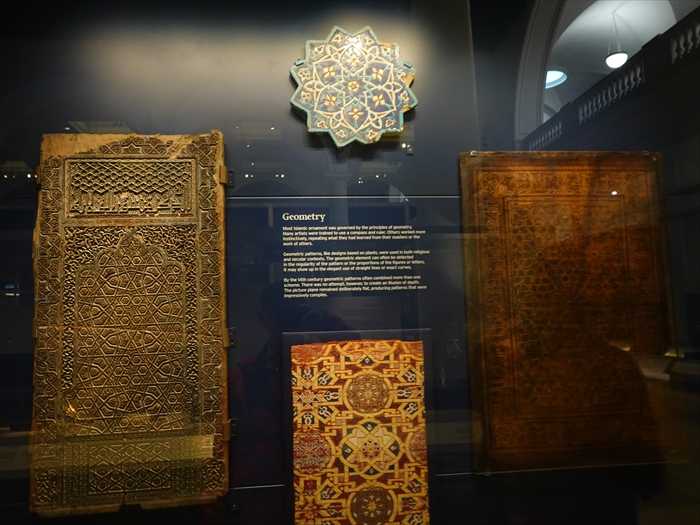
「 Geometry
Artists in the Islamic world were inspired by the principles of geometry.
With a compass and ruler, they created an infinite number of star patterns
and polygons.
and polygons.
These could be used alone or overlaid with floral and calligraphic decoration.
Geometry was also important in architecture, with complex vaulting and domes often
decorated with star patterns.
The 16-pointed star (top) is from a panel from the Alhambra Palace, Spain,decorated with star patterns.
14th century. The tooled leather bookbindings (left and right) were made in Iran
in the 15th century. The painted page (below) is from a 16th-century Iranian
manuscript.」
【幾何学
イスラーム世界の芸術家たちは、幾何学の原理に強く触発されました。コンパスと定規を
用いて、無限に広がる星形文様や多角形を生み出しました。これらは単独で用いられる
こともあれば、植物文様や書道的装飾と重ね合わせて使われることもありました。
幾何学は建築においても重要であり、複雑なヴォールト(アーチ天井)やドームには、
星形文様がしばしば施されました。
上部の16角星文様は、14世紀スペインのアルハンブラ宮殿のパネルの一部です。
左右の型押し革装丁の書物は、15世紀イラン製。
下の彩色されたページは、16世紀イランの写本からのものです。】

・上段のタイル(青・金・白の装飾):幾何学的・植物的文様で詩の世界観を 補完する装飾。
・中段のガラス器(ピンクや透明の彩色ガラス):宮廷や富裕層の詩歌朗読・饗宴で 用いられた器物。
・下段の大皿(青・白・黄色の彩色陶器):詩文や文学的モチーフに基づく装飾を 施した日常器。

「 Images and Poetry
In many Islamic societies, scenes containing humans and animals were a common
type of decoration in non-religious contexts. The source of this imagery was usually
poetry, the most highly esteemed form of secular literature.
type of decoration in non-religious contexts. The source of this imagery was usually
poetry, the most highly esteemed form of secular literature.
Luxury copies of narrative poems were often illustrated with fine paintings, and
themore familiar episodes were depicted on palace walls and objects. Love lyrics
accompanied portrayals of beautiful young men and women. Odes in praise of
the ruler inspired enthronement scenes. The recitation of poems at court was
depicted,as were princely activities such as hunting and playing polo.
In certain times and places, however, the ban on images in religious contextsthemore familiar episodes were depicted on palace walls and objects. Love lyrics
accompanied portrayals of beautiful young men and women. Odes in praise of
the ruler inspired enthronement scenes. The recitation of poems at court was
depicted,as were princely activities such as hunting and playing polo.
was extended to the secular sphere, and decoration was confined to calligraphic,
geometric and plant-based ornament.」
【 イメージと詩
多くのイスラーム社会において、人間や動物を含む場面は、宗教的でない文脈における装飾の
一般的な題材でした。こうした図像の源は通常、世俗文学の中で最も高く評価されていた
「詩」でした。
一般的な題材でした。こうした図像の源は通常、世俗文学の中で最も高く評価されていた
「詩」でした。
叙事詩の豪華な写本はしばしば精緻な絵画で彩られ、よく知られた物語の場面は宮殿の壁や
器物に描かれました。恋愛詩は、美しい若者や女性の姿とともに表現され、支配者を讃える
頌詩は即位の場面を鼓舞しました。宮廷での詩の朗読の様子も描かれ、また狩猟やポロ競技と
いった王侯の活動も表現されました。
しかし、時代や場所によっては、宗教的文脈における「図像の禁止」が世俗領域にも及び、器物に描かれました。恋愛詩は、美しい若者や女性の姿とともに表現され、支配者を讃える
頌詩は即位の場面を鼓舞しました。宮廷での詩の朗読の様子も描かれ、また狩猟やポロ競技と
いった王侯の活動も表現されました。
装飾は書道的・幾何学的・植物的文様に限定されることもありました】

イスラーム陶器の大鉢 。
・白地に黒の唐草模様
細かい蔓草(アラベスク)文様が放射状に展開しており、中心から外側へと視線が広がる
設計。イスラーム美術に特有の「無限の広がり」を象徴。
設計。イスラーム美術に特有の「無限の広がり」を象徴。
・青とトルコ石色のメダリオン
唐草文の中にリズムよく配置された青の装飾モチーフが、単調さを避けるアクセントに
なっている。これもイスラーム陶器の伝統的配色。
なっている。これもイスラーム陶器の伝統的配色。
・器形
高台が付いた大鉢で、儀式用または宮廷での宴席用に使われたのであろう。
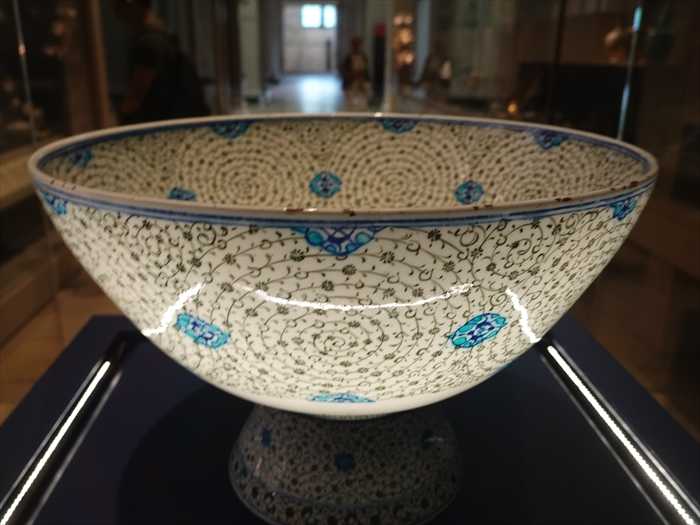
「 Basin with ‘Golden Horn’ Design
Turkey, probably Iznik
About 1545
This basin is decorated with tight concentric scrolls in black, which bear tiny leaves
and flowers. This pattern is often known as the ‘Golden Horn’ design, because
examples were excavated near the inlet in Istanbul known as the Golden Horn.
and flowers. This pattern is often known as the ‘Golden Horn’ design, because
examples were excavated near the inlet in Istanbul known as the Golden Horn.
Blue and turquoise motifs are set into the pattern. They resemble the enamelled
plaques found on some silverware of the same period.
plaques found on some silverware of the same period.
Fritware painted under the glaze
Museum no. 243-1876」【 「黄金の角」文様の鉢
トルコ(おそらくイズニク)
約1545年
この鉢は黒色の密な同心渦巻き模様で装飾され、その渦の中には小さな葉や花が
描かれています。この文様は一般に「黄金の角(ゴールデン・ホーン)」デザインとして
知られており、イスタンブールの入り江「ゴールデン・ホーン」付近から多数の例が出土した
ことに由来します。
描かれています。この文様は一般に「黄金の角(ゴールデン・ホーン)」デザインとして
知られており、イスタンブールの入り江「ゴールデン・ホーン」付近から多数の例が出土した
ことに由来します。
青とトルコ石色のモチーフが文様の中に組み込まれており、同時期の銀器に見られる
エナメル装飾を思わせます。
エナメル装飾を思わせます。
フリット陶器、釉下彩
館蔵番号:243-1876】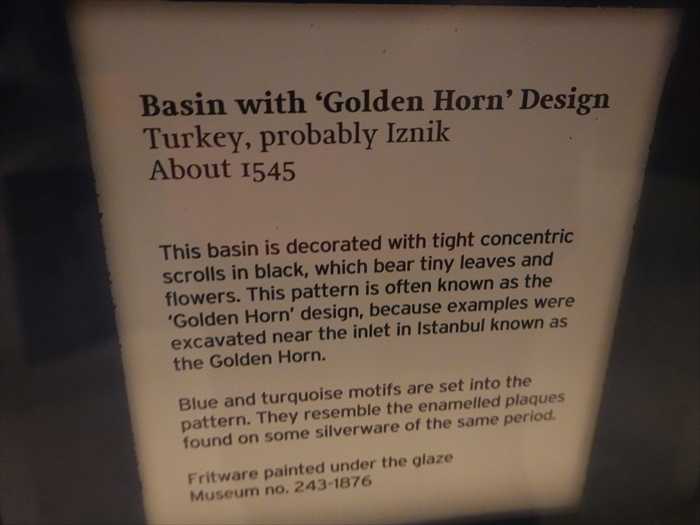
「 オスマン帝国期のトルコ美術(Turkey under the Ottomans) 」の展示解説パネル。
1.白地に青・緑・赤の絵付け
・白い錫釉(tin-glazed)の上に、コバルトブルー、エメラルドグリーン、トマトレッドなど
鮮やかな色で文様が描かれています。
鮮やかな色で文様が描かれています。
・特に「イズニク赤」と呼ばれる濃厚な赤色は16世紀半ば以降の特徴で、高級品に 用いられました。 2.花文(Floral motifs)
・チューリップ、カーネーション、ヒヤシンス、バラなどがよく登場します。
これらはオスマン宮廷文化を象徴する花であり、イスラム的な楽園のイメージとも
結びついていました。
これらはオスマン宮廷文化を象徴する花であり、イスラム的な楽園のイメージとも
結びついていました。
・花々は曲線的に絡み合い、リズミカルなパターンを構成。器の全面に生命感あふれる
「楽園的世界」を展開しています。
「楽園的世界」を展開しています。
3.シンメトリー(対称性)
・花の配置や唐草文は幾何学的秩序を保ちつつ有機的に描かれています。
・これはイスラム美術の重要な理念「無限の調和」と「神の秩序」を象徴しています。

「 Turkey under the Ottomans
Anatolia – the Asian part of modern Turkey – was settled by Muslim Turks from
about 1070 onwards. In the following century a sultanate was founded there by
the Seljuk dynasty. By 1300 this state had disintegrated, and a new dynasty,
the Ottomans, arose. From their base in the northwest, the Ottomans conquered
the rest of Anatolia and the Balkans, and in 1453 they seized Constantinople
(Istanbul), which became their capital.
about 1070 onwards. In the following century a sultanate was founded there by
the Seljuk dynasty. By 1300 this state had disintegrated, and a new dynasty,
the Ottomans, arose. From their base in the northwest, the Ottomans conquered
the rest of Anatolia and the Balkans, and in 1453 they seized Constantinople
(Istanbul), which became their capital.
The overthrow of the Mamluks of Egypt in 1517 and similar successes gave the
Ottomans an empire that stretched from Algeria to Iraq and included the holy sites
of Mecca and Medina.
In the 16th century, the wealth of the Ottomans was reflected in sumptuousOttomans an empire that stretched from Algeria to Iraq and included the holy sites
of Mecca and Medina.
decorative arts. Their bold designs rarely included human or animal figures,
a feature that was deliberately designed to distinguish them from those produced
in Iran at this time.」
【オスマン帝国時代のトルコ
アナトリア(現代トルコのアジア側)は、1070年頃からイスラム教徒のトルコ人によって
定住が始まりました。翌世紀にはセルジューク朝によってスルタン国が建てられましたが、
1300年頃までにその国家は崩壊し、新たにオスマン朝が興りました。オスマン朝は北西部を
拠点にアナトリア全土とバルカン半島を征服し、1453年にはコンスタンティノープル
(現イスタンブール)を攻略して首都としました。
定住が始まりました。翌世紀にはセルジューク朝によってスルタン国が建てられましたが、
1300年頃までにその国家は崩壊し、新たにオスマン朝が興りました。オスマン朝は北西部を
拠点にアナトリア全土とバルカン半島を征服し、1453年にはコンスタンティノープル
(現イスタンブール)を攻略して首都としました。
1517年にはエジプトのマムルーク朝を打倒し、同様の征服を重ねることで、オスマン帝国は
アルジェリアからイラクにまで及び、メッカとメディナという聖地も支配する大帝国と
なりました。
16世紀には、オスマン帝国の富は豪華な装飾芸術に反映されました。彼らの力強いデザインはアルジェリアからイラクにまで及び、メッカとメディナという聖地も支配する大帝国と
なりました。
人物や動物の図像をほとんど含まず、これは当時のイランの作品との差別化を意図して
いました。】
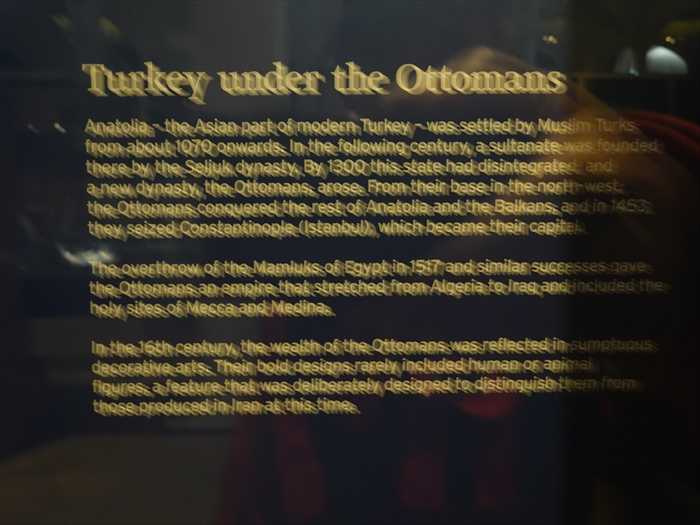
「Vase with FlowersTurkey, probably IznikAbout 1575Ceramics with a white fritware
body were a distinctive part of Ottoman art. Potters often showed great skill in
matching the designs they used to the shapes of vessels. Here tulips, carnations
and other flowering plants seem to sway gently in a breeze, following the curved
shape of the vase.Fritware painted under the glazeMuseum no. 232-1876」
【 1 花文様の花瓶
トルコ(おそらくイズニク)
約1575年
白い素地(フリット陶)の陶器は、オスマン美術の特色ある要素でした。陶工たちは器の形に
合わせてデザインを調和させる高度な技術を示しました。この花瓶では、チューリップや
カーネーションなどの花々が、器の曲線に沿ってそよ風に揺れるかのように描かれています。
合わせてデザインを調和させる高度な技術を示しました。この花瓶では、チューリップや
カーネーションなどの花々が、器の曲線に沿ってそよ風に揺れるかのように描かれています。
素材:白釉下彩のフリット陶
収蔵番号:232-1876】「 2 Two Tiles Forming Decorative Arch
Turkey, probably Iznik
About 1575
From the 1550s, white fritware was also used for wall tiles. This pair was made to
frame a small niche in a wall. Niches were often used for storage, in place of furniture.
They were also used for the display of objects suggesting refinement, such as
a vase of flowers.
frame a small niche in a wall. Niches were often used for storage, in place of furniture.
They were also used for the display of objects suggesting refinement, such as
a vase of flowers.
Fritware painted under the glaze
Museum no. 1897&A-1897」 【 2 装飾アーチを形成する二枚のタイル
トルコ(おそらくイズニク)
約1575年
1550年代以降、白い素地(フリット陶)は壁タイルにも用いられました。この一対の
タイルは、壁の小さなくぼみ(ニッチ)を縁取るために作られたものです。ニッチは
しばしば家具の代わりに収納として使われましたが、花瓶のような洗練を示す物品を飾る
ためにも用いられました。
タイルは、壁の小さなくぼみ(ニッチ)を縁取るために作られたものです。ニッチは
しばしば家具の代わりに収納として使われましたが、花瓶のような洗練を示す物品を飾る
ためにも用いられました。
素材:白釉下彩のフリット陶
収蔵番号:1897&A-1897】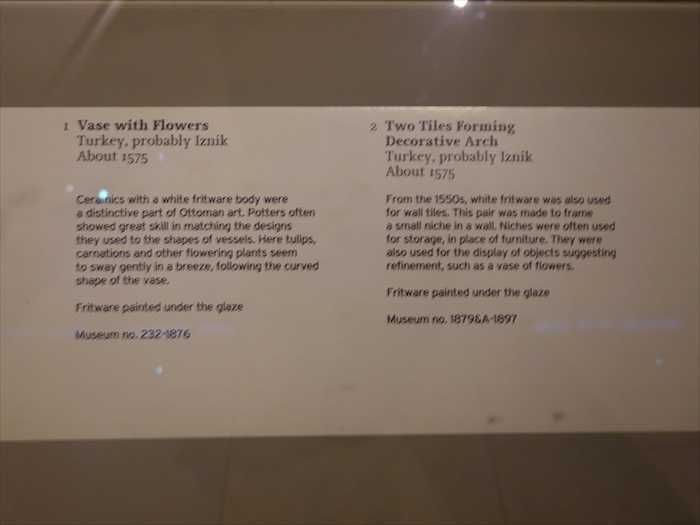
オスマン帝国時代の織物・刺繍布(Textiles / Embroideries) の展示。
上段
・赤地に円文様(メダリオン柄)
・規則正しい円(メダリオン)が並ぶ幾何学的パターン。
・円の中には花や太陽を思わせるモチーフが入ることも多く、「完全性・永遠」を象徴します。
・こうした布は壁掛けや法衣、儀式用の装飾布として用いられました。
下段(左から順に)
1.扇状の植物文様
・棕櫚(パーム)や蓮、あるいは生命の樹を思わせる形。
・豊穣や生命力の象徴とされました。
2.赤地に緑の円文様
・半円形に配された葉や花が繰り返し登場。
・モスクや宮殿で用いられた壁面装飾用の布地のデザインにも近いものです。
3.金糸刺繍の花文様
・中央に大きな花(菊や太陽を思わせる形)、周囲に唐草模様。
・金糸を多用しており、宮廷の高位者の衣装や儀礼用の幕に使用された可能性があります。
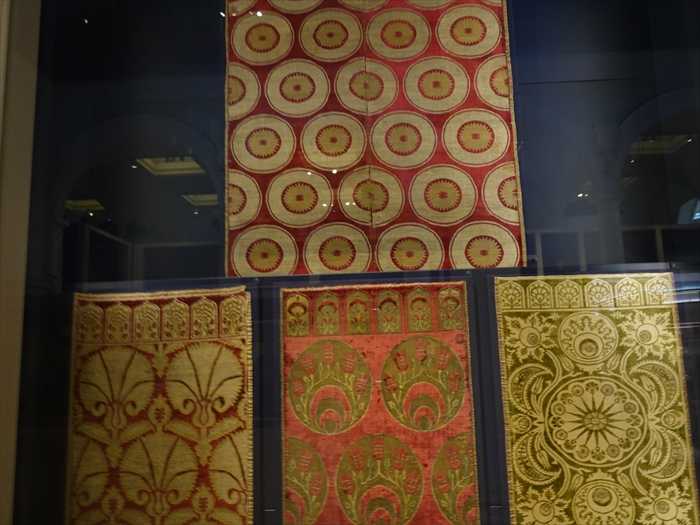
「 Ottoman Silks and Velvets
The Ottomans used luxurious silk textiles for furnishings and for men's and women's
clothing. The most prestigious were velvet and complex silk weaves called kemha
and seraser. These often incorporated thread wrapped with silver or gilded silver.
clothing. The most prestigious were velvet and complex silk weaves called kemha
and seraser. These often incorporated thread wrapped with silver or gilded silver.
The main centre for silk-weaving was Bursa in north-west Anatolia in Turkey.
The industry was established there in the 15th century, largely to compete with
Italian imports.
Velvet brocade, or çatma, was used for clothing as well as furnishings, such as theThe industry was established there in the 15th century, largely to compete with
Italian imports.
three cushion covers displayed here. The designs were created with bright motifs
of metal-wrapped thread set against the silk velvet background.」
【 オスマン帝国の絹織物とビロード
オスマン帝国では、豪華な絹織物が家具調度や男女の衣服に用いられました。
最も高級とされたのはビロード(ヴェルヴェット)や、ケマ(kemha) や セラセル
(seraser) と呼ばれる複雑な絹織物でした。これらにはしばしば、銀線や金箔で覆われた
糸が織り込まれていました。
(seraser) と呼ばれる複雑な絹織物でした。これらにはしばしば、銀線や金箔で覆われた
糸が織り込まれていました。
絹織物の主な生産地はトルコ北西部アナトリア地方のブルサで、15世紀に産業として
確立され、イタリアからの輸入品に対抗するためでもありました。
ビロード織金襴(チャトマ çatma)は衣服だけでなく、ここに展示されている3枚の確立され、イタリアからの輸入品に対抗するためでもありました。
クッションカバーのように家具調度にも使われました。文様は金属糸で織り出され、
絹のビロード地の上に鮮やかに浮かび上がるように表現されました。】
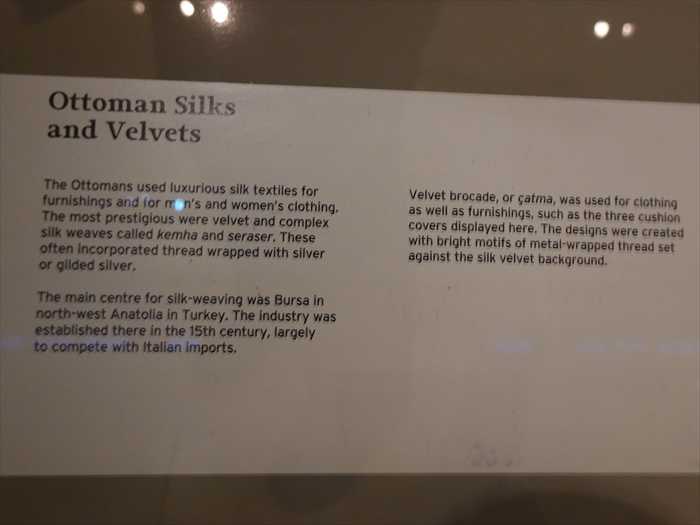
オスマン帝国期またはペルシャ(イラン)起源の絨毯(カーペット) 展示。
・ 左側の赤地の大絨毯
・中央に大きなメダリオン(中心装飾模様)があり、そこから広がる放射状の唐草や
アラベスク模様が展開されています。
アラベスク模様が展開されています。
・周縁には細密な花文様の縁取り(ボーダー)がめぐらされ、中央の赤と青のコントラストが
強い印象を与えます。
強い印象を与えます。
・このタイプはしばしば「メダリオン絨毯」と呼ばれ、サファヴィー朝イランやオスマン帝国の
宮廷織工房で製作されたものと。
宮廷織工房で製作されたものと。
・右側の展示(奥の赤い地の絨毯と下の断片)
・繰り返し文様(リピートパターン)が使われ、菱形(ダイヤ型)の枠の中に花文や唐草が
配されていた。
配されていた。
・下部の断片も同系統で、おそらく大きな絨毯の一部を切り取ったものか、同じ工房で
織られた装飾断片 と。
織られた装飾断片 と。
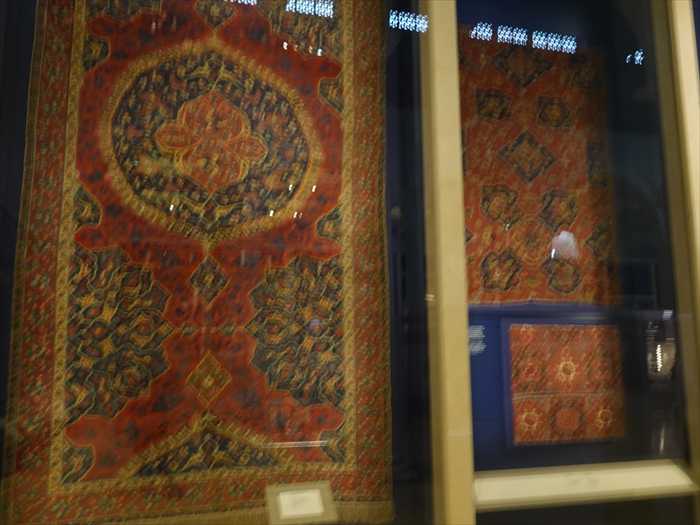
「ミフラーブ(Mihrab)」 と呼ばれるイスラム建築の要素 を有した 暖炉。
ミフラーブとは
・機能
モスク(イスラム教寺院)の壁面に設けられる祈りの方向( キブラ=メッカの方向)を
示す窪み(ニッチ) です。
示す窪み(ニッチ) です。
信徒が礼拝する際、このミフラーブの方向に向かって祈ります。
・形態
この展示品のように、 装飾的なアーチとタイルで縁取られた半円形・多角形の凹み
が
一般的。
一般的。
時代や地域によって異なりますが、特にオスマン帝国やイランのモスクでは鮮やかな
イズニク陶器やタイルで覆われたミフラーブが多く見られます。
・特徴 ・青・白・トルコブルーの色彩
イズニク陶器やタイルで覆われたミフラーブが多く見られます。
・特徴 ・青・白・トルコブルーの色彩
典型的なイズニク陶器の配色で、16世紀オスマン帝国期を思わせます。
・植物文様(唐草・花文)
アラベスク文様が全面を覆い、楽園の庭を象徴。イスラム美術で好まれる「永遠性」
「神の無限性」を表しています。
「神の無限性」を表しています。
・円錐状の装飾冠
窪みの上部に張り出した円錐形の冠(カノピー)があり、礼拝空間のいイメージを
際立たせています。
際立たせています。
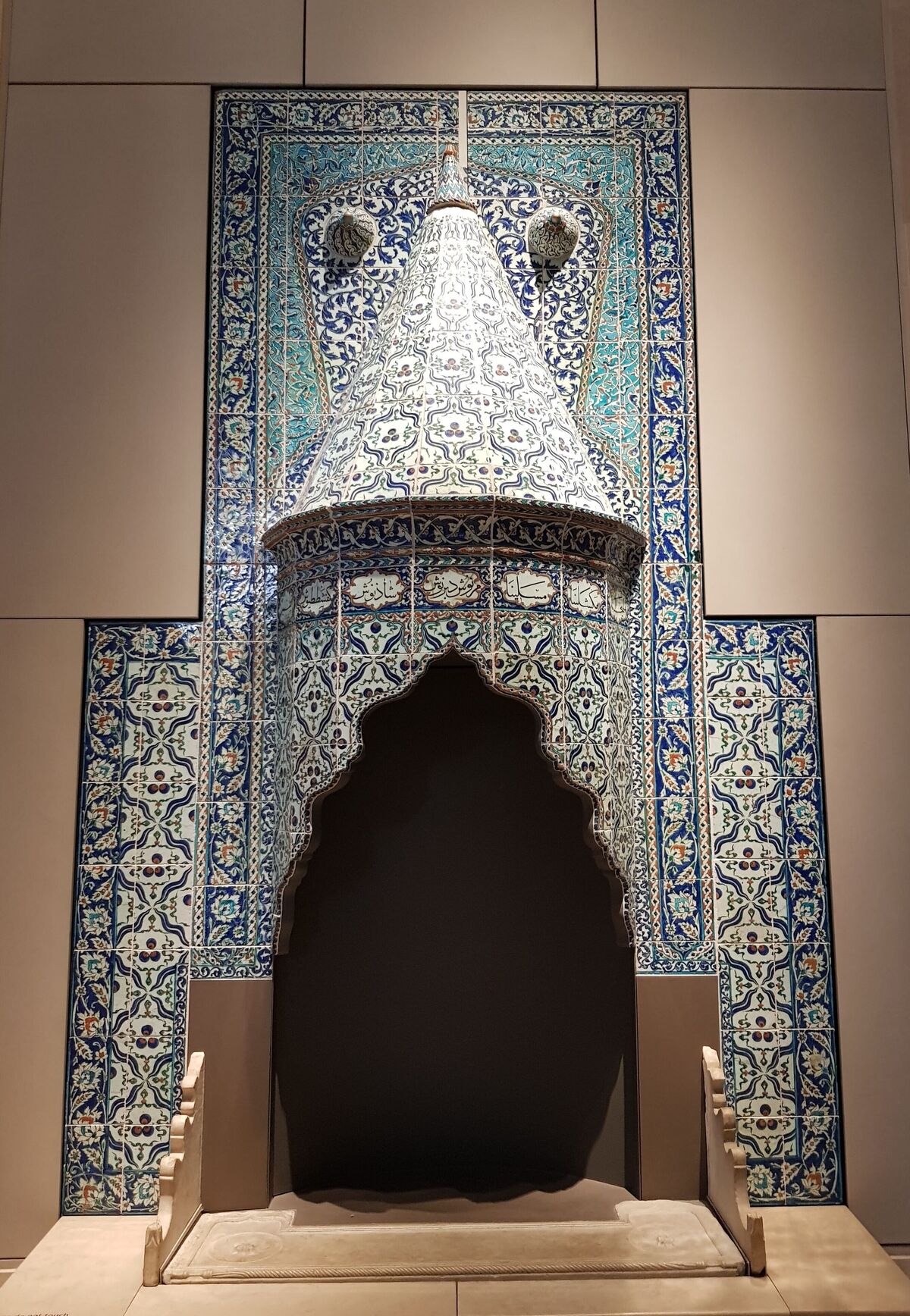 近づいて。
近づいて。 Tilework Chimneypiece(タイル装飾の暖炉)
・オスマン帝国の住宅や宮殿で用いられた暖炉の囲い。
・1731年製作(イスタンブール、おそらくトプカプ宮殿や高位役人の館のため)。
・ミフラーブと同じアーチ形・タイル装飾を持ち、外観的には酷似。
ただし機能は暖炉=暖房具で、宗教的な礼拝設備ではない。

横から暖炉の造形を。

「Tilework Chimneypiece(タイル装飾の暖炉囲い)」 に使われていた一枚。
・色彩:
典型的なオスマン期イズニック陶器の配色である
・コバルトブルー(青)
・トルコブルー(ターコイズ)
・赤(鉄赤=アルメニアン・ボレ)
・緑(銅緑) の組み合わせ。
・文様:
・中央から放射状に広がる青い曲線は、花弁や葉の動きを象徴し、流れるようなリズムを生む。
・周囲に小花(カーネーションやチューリップを抽象化)が散りばめられている。
・青い円形の文様は「ルーマル(雲形文様)」と呼ばれることがあり、トルコ・イランの
装飾芸術で好まれたモチーフ。
装飾芸術で好まれたモチーフ。

「 Tilework Chimneypiece
(right)
Turkey, probably Istanbul
Dated 1731
The names around the hood are those of the Seven Sleepers. Persecuted under
the Roman emperor Decius, these Christian men took refuge in a cave.
They fell asleep, waking centuries later under Christian rule.
the Roman emperor Decius, these Christian men took refuge in a cave.
They fell asleep, waking centuries later under Christian rule.
The Seven Sleepers are mentioned in the Qur’an as an example of God’s protection of
the righteous. Their names were therefore used to invoke that protection.
the righteous. Their names were therefore used to invoke that protection.
Fritware with under-glaze decoration
Museum no. 703-1891」 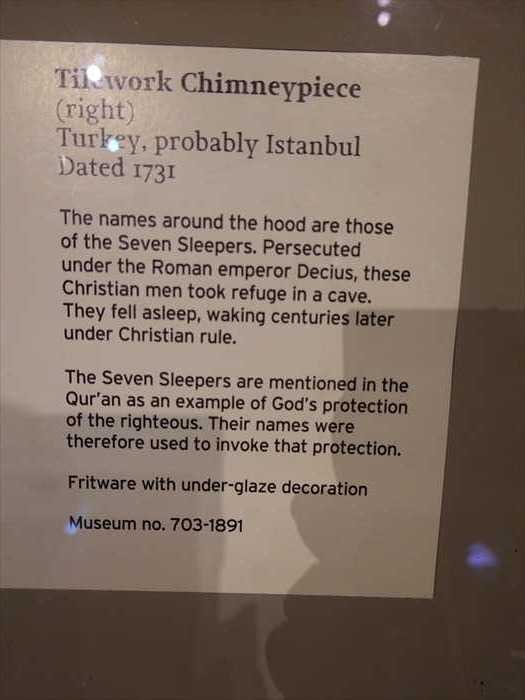
中東イスラーム世界の八角形小卓(side table, coffee table)。
・天板(上面)
・中央に青を基調とした幾何学的星形文様(八芒星の展開)と植物唐草。
・典型的なイズニック陶器の色調(コバルトブルー、ターコイズ、白、赤)が見えます。
・周囲の帯は水色と濃紺の反復文様で縁取られ、秩序と無限性を強調。
・側面(幕板部分)
・白いアラベスク(植物唐草)を濃色地に象嵌したもの。
・曲線がリズミカルに連続し、生命力と楽園を象徴。
・意味と象徴
・幾何学文様:イスラーム装飾の中心で、宇宙の秩序や神の無限性を示す。
・花文様(唐草、チューリップ、カーネーションなど):楽園(パラダイス)を象徴し、
王朝の繁栄や祝福を表現。
王朝の繁栄や祝福を表現。
・八角形:東西世界で調和と安定を象徴する形で、イスラーム建築のドームや噴水台、
礼拝具にも頻出。
礼拝具にも頻出。

「Tile-top TableTurkey, Iznik and IstanbulAbout 1560In Ottoman palaces, guests sat
on a low bench, or divan, built against the wall. Trays of food and drink were set
before them, resting on tables of this type.Wood faced with ebony, with inlay of
ivory and mother-of-pearl; fritware painted under the glazeMuseum no. C.19-1987」
【 タイル天板の卓子(テーブル)
トルコ、イズニクおよびイスタンブル
約1560年
オスマン帝国の宮殿では、客人は壁際に設けられた低いベンチ(ディヴァン)に座りました。
彼らの前には食べ物や飲み物を載せた盆が、このようなタイプのテーブルの上に置かれました。
彼らの前には食べ物や飲み物を載せた盆が、このようなタイプのテーブルの上に置かれました。
黒檀で面を張った木製の骨組みに、象牙と真珠貝の象嵌を施し、天板は釉下彩で装飾された
フリット陶器。
館蔵番号:C.19-1987】フリット陶器。

オスマン帝国期のイズニク陶器(Iznik ceramics)とタイル装飾の展示
。
・中央のガラスケース
・16世紀後半~17世紀にかけての イズニク陶器の皿や壺、瓶。
・白地にコバルトブルー・ターコイズ・エメラルドグリーン・赤(アルメニアンレッド)で
描かれた華やかな文様が特徴。
描かれた華やかな文様が特徴。
・文様は 唐草(アラベスク)、チューリップ、カーネーション、ヒヤシンス、ザクロなど、
オスマン宮廷文化を象徴する植物が多い。
オスマン宮廷文化を象徴する植物が多い。
・周囲の壁面タイル
・左側:繰り返し文様の タイル・パネル。ザクロや葉をモチーフにした連続模様。
・右側・上部:装飾的なアーチを思わせるタイル。建築内部(モスクや宮殿)の壁面や ニッチ(壁龕)を飾ったもの。
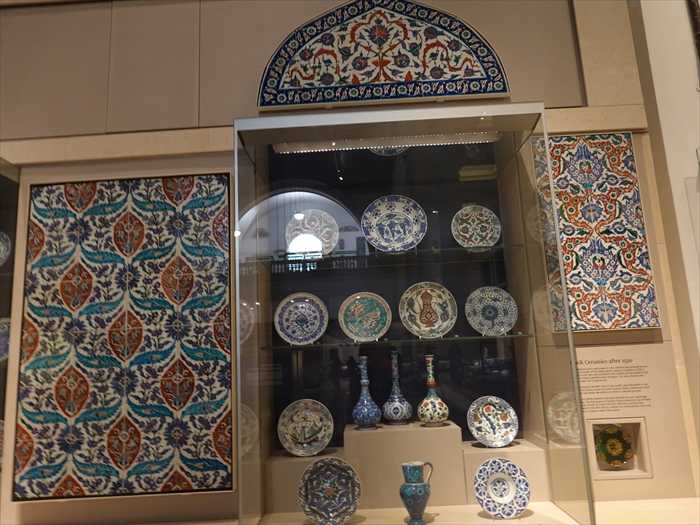
「 Variety of Shape and Design
motif (9, 10, 15), but from the 1550s these were replaced by compositions on alarger
scale. Many were originally developed for tilework (1, 3).」
【 形とデザインの多様性
一般的となっていました(9, 10, 15)。しかし1550年代以降、こうした小規模なモチーフは、
より大規模な構図へと置き換えられていきました。その多くはもともとタイル装飾用に
考案されたものでした(1, 3)。】

このタイルは 「イズニク陶器(Iznik Ceramics)」1550年以降 の代表的な装飾パネル で、
オスマン帝国の華やかな宮廷文化を反映したもの と。
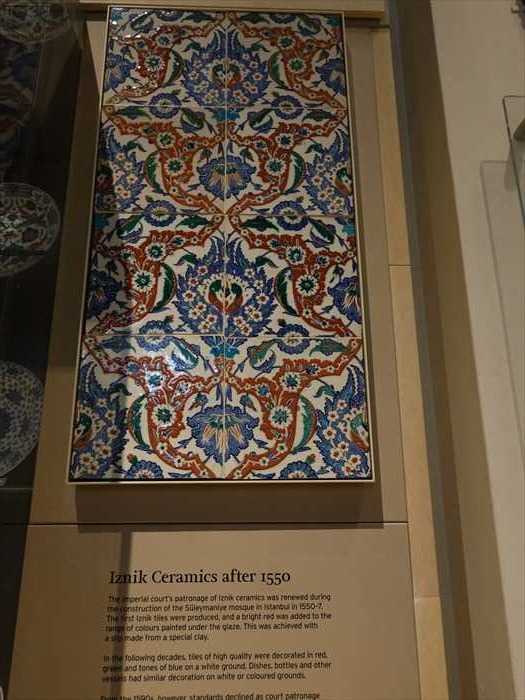
「 Iznik Ceramics after 1550
The tile industry in Iznik ceramic production was imitated by other towns (ifillegible?)
and local demand. Waning importance led eventually in the 18th century to former
imperial production being replaced in Istanbul called Tekfur Sarayi.」
【 1550年以降のイズニク陶器
タイル産業は他都市によって模倣され、地元需要に依存するようになりました。
その結果、18世紀にはイズニクの宮廷向け陶器生産は衰退し、イスタンブルの
「テクフル・サライ工房」に置き換えられていきました。】

「 Tiles with Repeat Pattern (top)
【 繰り返し模様のタイル(上部)
透明釉下彩のフリット陶器
館蔵番号 1886-1897】
「 Gilded Tile (above)
【 金彩タイル(上部)
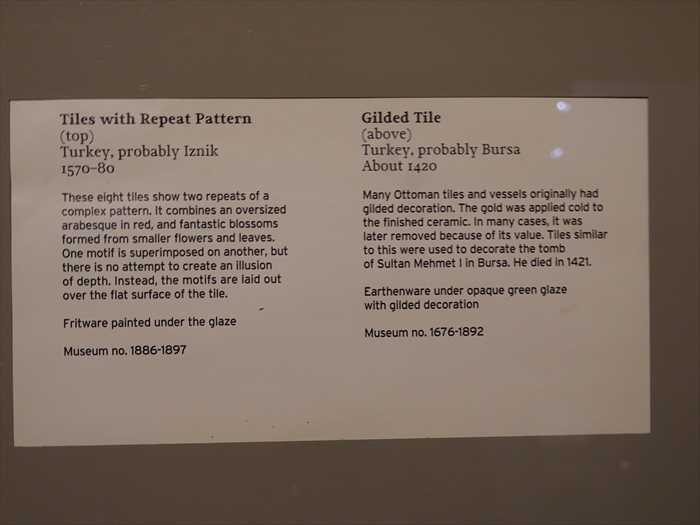
・・・ もどる ・・・
・・・ つづく ・・・
意匠と意味
・植物文様:
チューリップやカーネーションは、オスマン帝国の「楽園」を象徴する花。庭園文化や
イスラム的な天国イメージを反映。
イスラム的な天国イメージを反映。
・青と赤のコントラスト:
コバルトブルーは清浄と神聖さ、赤は生命力と富を象徴。16世紀半ばに登場した
アルメニアンレッドは、イズニク陶器の代表的特徴。
アルメニアンレッドは、イズニク陶器の代表的特徴。
・幾何学と反復文様:
無限性・秩序・神の創造の永遠性を表すイスラム美術の典型モチーフ。

「 Variety of Shape and Design
The shapes of Iznik vessels were derived from sources as varied as metalwork (9–11), leatherwork (14) and Chinese and Italian ceramics. Models included the Chinese‘grape
dish’ (2) and the Italian tondino form (15).
By the 1530s, small sprays of tulips and other recognisable flowers were a commondish’ (2) and the Italian tondino form (15).
motif (9, 10, 15), but from the 1550s these were replaced by compositions on alarger
scale. Many were originally developed for tilework (1, 3).」
【 形とデザインの多様性
イズニク陶器の形は、金属製品(9–11)、革製品(14)、さらには中国やイタリアの陶磁器と
いった多様な素材や伝統から着想を得ていました。モデルには、中国の「ブドウ文皿」(2)や、
イタリアの トンディーノ 形(15)などが含まれます。
1530年代までには、チューリップやその他の認識しやすい花を小枝状に描いたモチーフがいった多様な素材や伝統から着想を得ていました。モデルには、中国の「ブドウ文皿」(2)や、
イタリアの トンディーノ 形(15)などが含まれます。
一般的となっていました(9, 10, 15)。しかし1550年代以降、こうした小規模なモチーフは、
より大規模な構図へと置き換えられていきました。その多くはもともとタイル装飾用に
考案されたものでした(1, 3)。】

このタイルは 「イズニク陶器(Iznik Ceramics)」1550年以降 の代表的な装飾パネル で、
オスマン帝国の華やかな宮廷文化を反映したもの と。
1.中央の大輪の花
・青(コバルトブルー)の大きな花(しばしばカーネーションやロータスに解釈される)が
中心に置かれています。
中心に置かれています。
・その周囲に赤(イズニク特有の鉄赤)の花弁が広がり、放射状のバランスを作っています。
2.チューリップ文様
・上下左右に細長い赤い花弁が伸びており、これはオスマン陶器の典型的な「チューリップ」。
・チューリップは16世紀以降のオスマン帝国を象徴する花で、王権や繁栄のシンボルでした。
3.カーネーション文様
・外側の赤い花弁の中に、ギザギザした花弁を持つカーネーションが見られます。
・カーネーションは生命力と永遠性を意味します。
4.唐草(アラベスク)と小花
・青や緑の唐草文様が花々をつなぐように広がり、全体を調和させています。
・細かい小花(青や白の点状)は、天上の楽園を象徴する「無限の花園」のイメージです。
5.対称構造
・ 模様は上下左右に完全に対称に配置されており、イスラーム美術の「宇宙的秩序」
「神の無限性」を表しています。
・ 模様は上下左右に完全に対称に配置されており、イスラーム美術の「宇宙的秩序」
「神の無限性」を表しています。

「 Iznik Ceramics after 1550
The imperial court’s patronage of Iznik ceramics was renewed during the construction
of the Suleymaniye mosque in Istanbul in 1550s.
of the Suleymaniye mosque in Istanbul in 1550s.
The finest tiles were produced, and a bright red was added to the range of colours
painted under the glaze. This was achieved with a slip made from a special clay.
painted under the glaze. This was achieved with a slip made from a special clay.
In the following decades, tiles of high quality were decorated in red, green, turquoise,
blue on a white ground. Dishes, bottles and other vessels had similar decoration
on white or coloured grounds.
From the 1580s, however, standards declined and court patronage ceased.blue on a white ground. Dishes, bottles and other vessels had similar decoration
on white or coloured grounds.
The tile industry in Iznik ceramic production was imitated by other towns (ifillegible?)
and local demand. Waning importance led eventually in the 18th century to former
imperial production being replaced in Istanbul called Tekfur Sarayi.」
【 1550年以降のイズニク陶器
オスマン帝国の宮廷によるイズニク陶器の保護は、1550年代のイスタンブルにおける
スレイマニエ・モスクの建設に際して新たに強化されました。
スレイマニエ・モスクの建設に際して新たに強化されました。
この時期に最上質のタイルが制作され、さらに明るい赤色が釉下彩の色調に加えられました。
これは特別な粘土から作られた化粧土(スリップ)を用いることで実現されました。
これは特別な粘土から作られた化粧土(スリップ)を用いることで実現されました。
その後の数十年間には、赤・緑・トルコ青・青が白地に描かれた高品質のタイルが生み
出されました。皿や瓶などの器物もまた、白地や彩色された地に同様の装飾が施されました。
しかし1580年代以降、品質は次第に低下し、宮廷の庇護も途絶えました。イズニク陶器の出されました。皿や瓶などの器物もまた、白地や彩色された地に同様の装飾が施されました。
タイル産業は他都市によって模倣され、地元需要に依存するようになりました。
その結果、18世紀にはイズニクの宮廷向け陶器生産は衰退し、イスタンブルの
「テクフル・サライ工房」に置き換えられていきました。】

「 Tiles with Repeat Pattern (top)
Turkey, probably Iznik
1570–80
These eight tiles show two repeats of a complex pattern. It combines an oversized
arabesque in red, and fantastic blossoms formed from smaller flowers and leaves.
One motif is superimposed on another, but there is no attempt to create an illusion
of depth. Instead, the motifs are laid out over the flat surface of the tile.
arabesque in red, and fantastic blossoms formed from smaller flowers and leaves.
One motif is superimposed on another, but there is no attempt to create an illusion
of depth. Instead, the motifs are laid out over the flat surface of the tile.
Fritware painted under the glaze
Museum no. 1886-1897」【 繰り返し模様のタイル(上部)
トルコ、おそらくイズニク製
1570~1580年頃
これら8枚のタイルは、複雑なパターンを2回繰り返して示しています。赤色の大きな
アラベスクと、小さな花や葉から構成された幻想的な花々を組み合わせています。モチーフは
重ね合わせられていますが、奥行きを錯覚させる意図はなく、むしろ平坦なタイルの表面
全体に模様を配置しています。
アラベスクと、小さな花や葉から構成された幻想的な花々を組み合わせています。モチーフは
重ね合わせられていますが、奥行きを錯覚させる意図はなく、むしろ平坦なタイルの表面
全体に模様を配置しています。
透明釉下彩のフリット陶器
「 Gilded Tile (above)
Turkey, probably Bursa
About 1420
Many Ottoman tiles and vessels originally had gilded decoration. The gold was applied
cold to the finished ceramic. In many cases, it was later removed because of its value.
Tiles similar to this were used to decorate the tomb of Sultan Mehmet I in Bursa.
He died in 1421.
cold to the finished ceramic. In many cases, it was later removed because of its value.
Tiles similar to this were used to decorate the tomb of Sultan Mehmet I in Bursa.
He died in 1421.
Earthenware under opaque green glaze with gilded decoration
Museum no. 1676-1892」【 金彩タイル(上部)
トルコ、おそらくブルサ製
1420年頃
多くのオスマン帝国のタイルや器は、もともと金彩で装飾されていました。
金は焼成後の陶器に冷間で施されるもので、多くの場合、後にその価値のために
削り取られました。このようなタイルは、ブルサにあるメフメト1世(在位1413~1421)の
墓を飾るために使われました。
金は焼成後の陶器に冷間で施されるもので、多くの場合、後にその価値のために
削り取られました。このようなタイルは、ブルサにあるメフメト1世(在位1413~1421)の
墓を飾るために使われました。
不透明な緑釉の上に金彩装飾を施した土器
館蔵番号 1676-1892】

・・・ もどる ・・・
・・・ つづく ・・・
お気に入りの記事を「いいね!」で応援しよう
Re:アイルランド・ロンドンへの旅(その122): ロンドン散策記・Victoria and Albert Museum・ヴィクトリア&アルバート博物館-5(10/28)
私はイスラム教徒です さん
『 (21) 人々よ、あなた方の主のみを崇めよ。なぜならかれはあなた方、そしてあなた方以前の人々を創造し、あなた方がかれの命令に従い、禁じることを遠ざけることにより、あなた方が苦痛から救済されるようにしたためである。
(22) かれこそは地上をあなた方の前に敷物のように延べ広げ、空をあなた方の上に打ち立てたお方である。またかれのご慈悲から、あなた方への糧として、種々の果実を実らす雨が降らされる。それゆえ、アッラーのみが崇拝に値すると知りながら、かれに同位の者がいるとみなしてはならない。
(23) 人々よ、もしクルアーンがムハンマドに啓示されたことを疑うのであれば、同様の章句をひとつでも創ってみなさい。そしてもし(その創られた章句で)真実を語っているのなら、あなた方の援助者を呼んでみなさい。
(24) もしそうすることができないのなら、いや、絶対にできるはずもないのだが、懲罰に値する人間と、かれらが崇めていた種々の石を燃料とする業火を恐れなさい。それは不信仰者のために用意されている。
(25) ここまでの警告は不信仰者たちに対してのものであるが、善行に励む信仰者たちへは吉報を伝えるよう、預言者は命じられる。楽園において、かれらの宮殿や木々の下には川が流れ、望むがまま果実を食する。それらは地上の果実と似通っている為、かれらはこう言及する。「これは以前、私たちが与えられていたものと似ている。」かれらは生前の果物と同様の名と形をしたものを与えられ、それらを認知し欲するが、それらの味わいは異なる。そして楽園において、かれらには純潔な伴侶がつくが、地上の人間が持つような不快な特徴は一切ない。そこでは地上のような儚い幸せとは無縁な、途切れることのない永久なる至福のなかにかれらは暮らす。』
(2025.10.28 19:00:41)
【毎日開催】
15記事にいいね!で1ポイント
10秒滞在
いいね!
--
/
--
© Rakuten Group, Inc.










